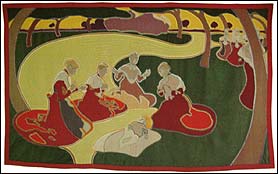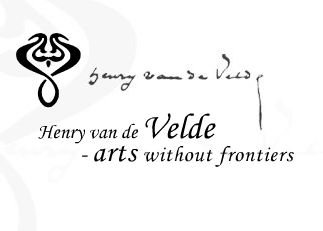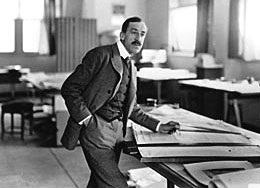In 1933, in a tribute delivered on the occasion of the 70th birthday of Henry van de Velde, Minister Camille Huysmans declared: "I not only consider Henry van de Velde to be a great artist in his own right but also someone who paved the way for others. You are familiar with his own work. In my opinion this is founded on constructive logic which has an aesthetic effect. Van de Velde has freed us from the organic, from the superfluous, from the ornamental which is so often added without regard for the structural form, and brought us back to purity of line and clear simplicity".
This description not only sounds flattering, it is also comprehensive in its succinctness. The long and intense life of Henry van de Velde is not, however, so easily summarised. Although his journey through Europe can be neatly divided into 5 periods (the first Belgian period, a German, a Swiss, a Dutch, and the second Belgian period), his immense production (architecture, furniture, textile, ceramics, metalwork, theoretical writings) will, despite the numerous publications wich have appeared, remain a permanent source of study for many years to come.
Henry van de Velde was born in Antwerp in 1863, the seventh of eight children. The bourgeois environment in which he grew up (his father was a chemist) originally suggested that the young Henry was set for a respectably middle-class career. A taste for adventure soon indicated that his life would take a quite different course: that of art. Although he was interested in music (the composer Peter Benoit was a friend of the family) he opted for the academy. In 1881 Henry van de Velde enrolled at the academy of his home town. He took courses in different kinds of drawing. At the request of the director of the academy Charles Verlat, he continued his studies at the latter's private studio. He was later to say of his years of at the academy: "miserable and wasted years. Academic education is inevitably oppressive and sterile. It is too far removed from the adventure and independence wich are the very essence of art."
When in 1884 he came across Manet's "Bar aux Folies Bergère" at an exhibition in Antwerp he was so moved by the work that he asked his father's permission to go and study in Paris. At the age of 21 he left for Paris to study at the studios of Bastien-Lepage and Carolus Duran. Although the Barbizon School held a great fascination for him, he was nevertheless to return to Antwerp disillusioned. At the suggestion of the painter Emile Claus, he paid a visit to the village of Wechelderzande, where the most famous Belgian luminists had settled. Originaly intending to make just for short stay in Wechelderzande, he finally remained there for 4 years. It was here that van de Velde came into real and close contact with rural life, a taste of wich he had already had in Barbizon. He wrote an essay while he was there entitled "Du paysan en peinture" (a historical, aesthetic and social analysis) and also produced a series of paintings and pastel drawings. His sojourn in Wechelderzande undoubtedly had an important influence on the subject matter of van de Velde's work. He himself wrote: "In the solitude of the Campine villages I became increasingly drawn to reading and reflection wich distanced le irrevocably from the anti-social forms of painting and the life of the artist as I had previously known it. Only someone who renders himself useful to everybody is really usefull, that is the message I received from both my heart and my understanding".
During his painting and drawing period, van de Velde was naturally bound to the flat surface, in which he endeavoured to organise a harmonious an animated expression. Later such aspiration was to shift from the flat surface to the treatment of the spatial in his architecture and applied arts. Despite the quality of his drawings, we are continually confronted with the evolution of van de Velde's understanding of aesthetics. In 1884 he consequently decided to abandon drawing and painting once and for all. In the autumn of 1888, van de Velde joined the Brussels group of artist. "Les XX" (the twenty), the way opened up to new spheres of interest and a broader field of activity. Although at first the salons of "Les XX" exibited only paintings, from 1890-91 they displayed a wider interest in the applied arts. Jules Cheret presented posters, Walter Crane Children's book, Gauguin his first exhibition of ceramics and A.W. Finch in addition to his painting, his first experimental ceramic plates. It was also at about this time that Brussels became one of the first cities in continental Europe to pick up on the production of the English company, Liberty. A shop belonging to the "Compagnie japonaise" sold Liberty varnished tables, fabric carpets, glassware and dinner services. It was no doubt A.W. Finch who first introduced Henry van de Velde to the thinking of Ruskin and Morris. Van de Velde was particulary attracted to social aspects of their work and their struggle for the art to be totaly integrated into everyday life in society through arts and crafts. The personal contact which van de Velde had, from 1886 onwards, with leading socialists such as Emile Vandervelde and Max Hallet made him particulary sensitive to the relationship between art en society.
| |
 |
| |
Angel's wake, 1892 |
1893 was to be an important year for Henry van de Velde, both artistically and personally. In the winter of 1892-93 his embroidery designs:"Engelenwake" (the angels watch) were produced by an aunt of the artist (and presented at what was to be the final salon of "les XX" in 1893).
At a party given by the painter Theo Van Rysselberghe he met a young apprentice of the artist. Her name was Maria Sethe, the daughter of a prominent industrialist from Uccle ((Brussels). Learning of his interest in arts and crafts, the young lady offered to supply him with information from London on current trends in English art. In this way Henry van de Velde was able to present an early collection of works in steel, and pieces representative of the progressive English applied arts. When, from Oktober 1893, he began lecturing two hours a week at the Antwerp Academy he used his own material to illustrate his points. In his autobiography van de Velde spoke about his teaching at the Academy: "On the basis of the reproductions and the original copies which I possessed, I studied the various branches of art and crafts and the development of the various techniques wich had recently made the transition from the manual to the mechanical. A revolution had taken place when not even the strongest opposition from Ruskin, whose paradoxical, eccentric attitude served only to diminish the strength of his protest, had been able to halt. It was unjust to blame the machine for the ugliness. It was however just to denounce the base avarice of the industrialists who - thanks to the machine - were able to mass produce the monstrosities wich had previously been handmade and flood the world markets with them. It is a fact that in the future their reputation would depend directly upon the aesthetic and moral value of the products manufactured in their factories."
These lessons, together with his courses at the "New University" of Brussels, where he gave a number of lectures on "The industrial arts and ornamentation" were to form the basis, in 1884, of his first publication: "Dèblaiement d'art" (33 pages in a limited edition of 150 copies). This was a typographical masterpiece and an ardent plea for a return to an art wich "requires the sacrifice of personal vanity and the overcoming of the contempt with which artistic pursuits of a functional nature have been treated. We wear ourselves out, creasely trying to laugh in an atmosphere of tedium".
In the meantime, on 30 April 1894, Henry van de Velde married Maria Sethe. The young couple went to live with Maria's mother. He was commissioned by his mother- in- law to take his first steps into the world of architecture: he undertook some alternations in the small family villa. Also on the instructions of his mother- in- law, van de Velde completed his first work of applied art: furniture for his sister-in-law Irma. Shortly afterwards Mrs. Sethe presented her son- in- law with the chance of making his dream come true by providing him with the means to build his own house on an adjoining plot of land: the BLOEMENWERF (1895-96), so- called in memory of a country house he had seen while on honeymoon in the Netherlands. Without any architectural training Henry van de Velde produced a work of architecture wich was a reflection of his theoretical concepts: a radical departure from any historical style, the expanding of the living areas wich stood in a relationship of organic unity, sobriety of design and above all an all- encompassing unity of architecture and applied art. Today it is a work which speaks for itself, although in 1895 it was a subject of derision and controversy. Despite some outwards resemblance to an English "cottage" the Bloemenwerf was considered an exceptionally revolutionary work. In van de Velde's opinion it was above all the logic and simplicity wich surprised both the public and the architects: "the unusual façade, the format and the lack of symmetry in the windows and the shape of the roof could probably have been forgiven. The lack of a specific external statement could not, especially as neither a shortage of funds nor a concern for economy was the explanation." The first architectural work of Henry van de Velde can certainly not be regarded as perfect. As an example of plastic art it leaves something to be desired and it is in marked contrast with Hogenhof for example (Hagen 1907). Bloemenwerf is above all a forceful statement in which Henry van de Velde gives a practical expression to the theory of his art. A theory wich can be expressed in two central concepts: rational design and strength of line, with which he made a radical departure from any imitation of historical styles. In Bloemenwerf, Henry van de Velde not only constructed the house with strict accordance with rational principles but he also designed the furniture: "I thought about everything which was unburdened by sentimentality and which stood before me in the purity of the simple creation of our understanding. The furniture of our house seemed perfectly clean to me, not remotely overloaded, as fresh as a remote corner of a bright valley. In its purity it seemed to defy all the clutter of the antique shops. The bright, polished ash and the ingenious details of the construction delighted both the eye and the spirit. Today it wouldn't astonish anyone, but at the time it created a sensation".
The sensation grew, fired by an exhibition of the Bloemenwerf furniture at the salon of "La libre esthétique" in 1986 (which replaced "Les XX" after 1894, under the inspired management of Octave Maus, and also in Paris, where Siegfried Bing wanted to set up "L' art Nouveau" following the example of the Brusssels "La maison d'art (1894)". Bing's plan for the first exhibition involved a clear departure from the stand and window presentation of the time: he wanted to present the works of art in a variety of salons and interiors which would show them off to their best advantage. In 1895 Bing invited Henry van de Velde to furnish four rooms of the new house in Paris: a large dining room, a smoking room in Congolese wood, a small cabinet in lemon wood and a rotunda with furniture and matching wall decorations. The exhibition caused a scandal and met with a largely critical response, not least because the exhibitors, and especially van de Velde, made a definitive break with the prevailing French taste. In a dialogue in his "journal" the work of Henry van de Velde prompted the following bitter comments from Edmond de Goncourt: "No - is this to be the future of French furniture? - no and no again."



